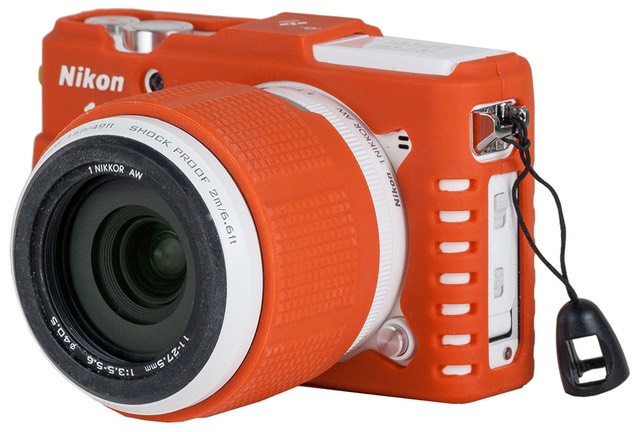
What is It?
Many years ago, Nikon made a line of underwater film cameras called the Nikonos. These were revered objects in the diving world, and for quite some time Nikon had a near lock on underwater photography. But that was a smallish market, and in the film world you didn’t actually need another new Nikonos once you had one, so iterations in that world became slow and far between.
It’s a little surprising that it took so long for Nikon to return directly to the ILC underwater world (though not diving cameras, per se). Most divers long ago just succumbed to underwater housings for their regular digital camera. We saw a few consumer compact cameras get “tough”, including the Coolpix AW100. But it wasn’t until the Nikon 1 AW1 that we’ve seen an interchangeable lens camera that was truly designed for getting dunked.
Overall, the Nikon AW1 is a “big Nikon J3.” The additional gasketing and other things that Nikon has done to keep water out make for a bigger camera. That’s especially true of the lenses. The 11-27.5mm AW lens is nearly the size of the regular 10-100mm lens. Even the 10mm AW lens is substantially bigger than you might expect if you’re used to the regular Nikon 1 lenses.
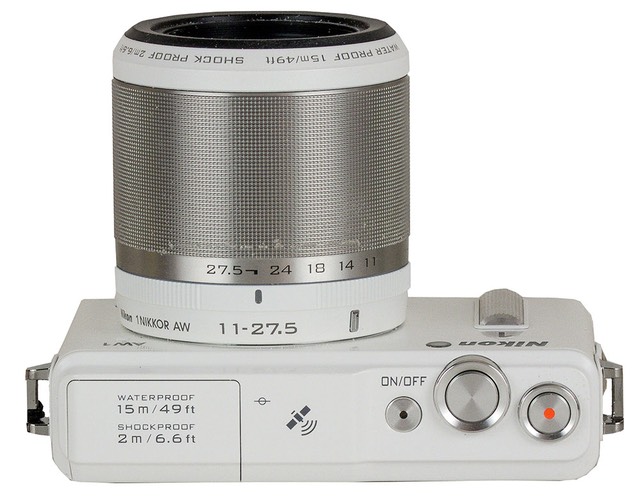
But let’s examine what you’re getting.
Nikon claims the AW1 is waterproof to 49 feet (15m). It claims it is shockproof (immune to drops of up to 6.6’ (2m). Plus Nikon claims the AW1 is freeze proof to 14°F (-10C). The AW1 is marketed as a camera that can handle all kinds of adversity. Along with the camera, Nikon announced AW versions of the 11-27mm (30-74mm equivalent) and 10mm (27mm equivalent) lenses, with similar “rugged” capabilities. Be aware, though, that if you place a regular Nikon 1 (CX) lens on the AW1 the camera loses the waterproof, shockproof, freezeproof claims.
As I noted, the AW1 is mostly a Nikon J3 with new packaging. That means a 14mp 1” sensor (2.7x crop), a 921k dot 3” LCD out back to handle all the framing, setting, and review abilities (e.g. no EVF available). As usual, we find the Nikon 1’s fast phase detect autofocus and high burst speeds present (15 fps with continuous focus, 60 fps without). Nikon did use the extra size of the AW1 to add a built-in GPS with compass and depth meter.
Surprisingly, the AW1 has a small pop-up flash (GN 21’/6.3m at ISO 160, but with a slow flash sync speed of 1/60). I’d judge this to be the weakest link of the rugged nature of the camera. While my camera hasn’t shown corrosion or other problems in this area, my guess is that because of the small metal parts used in the pop-up mechanism, it will be the first thing to cause issues if you handle this camera as ruggedly as Nikon suggests you can. I’ve had to be careful with sand getting into this area when using the camera snorkeling from beaches, for instance. You also don’t want the flash extended if you drop the camera. You get the point: the little flash is a potential weak point, as well as being a weak light.
Nikon claims that the controls have been beefed up for underwater/gloved operation, and yes, the buttons and Direction pad do appear to be different than those used on the J models. A little beefier, but still quite small.
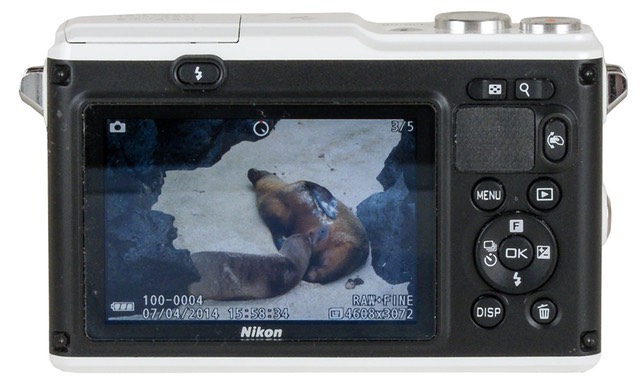
ISO settings from 160 to 6400 are supported, and in addition to Nikon’s usual White Balance and Picture Control settings, we get an additional underwater White Balance setting. Typical to the Nikon 1 models, we get both JPEG and 12-bit Compressed NEF support. The electronic/mechanical shutter combination gives you shutter speeds between 30 seconds and 1/16,000.
Video capabilities include 1080i/60 (or 1080P/30), 720P/60/30, plus 240P/400 and 120P/1200, the usual Nikon 1 specs. We also get the somewhat questionable Motion Snapshot feature, with no updates from the original.
You can add an optional WU-1b WiFi adapter to the camera, but then the connection port door would be open and the camera vulnerable to flooding, so this is yet another of those Nikon design dissonances we keep getting.
The AW1 uses the EN-EL20 battery, with a very limited CIPA life of 220 shots, mostly due to the GPS. Overall, the camera is still only 7 ounces (201g), despite all the beefing up needed to make it waterproof.
The camera is assembled in Indonesia, the lens in China, and are available Black, Silver, and White for US$750 with kit lens.
How’s it Handle?
We had a total of seven Nikon AW1 cameras amongst the group at last year's Galapagos workshop. While I didn’t get to work with the camera as much as I had hoped, my teaching assistant did, and I was able to observe and get comments from all the others that filled in a few gaps.
First some good and bad news. Most of these cameras were used in snorkeling daily for two weeks. All total there was probably over a 140 hours of in water use amongst the AW1 cameras on the trip (plus more above water). No flooded cameras. While some worry about the type of seals used on the two doors of the camera, they seem perfectly sufficient for snorkeling, swimming, rain, waterfalls, and the other types of uses most people would be using these cameras for. Nikon doesn’t advertise them as scuba diving cameras, and they’re not. For everything else involving water, though, they’re fine.
The bad news is that two of the cameras had persistent fogging issues (mostly on the LCD, but also on sealed lenses). This indicates that some small level of moisture had gotten into places it shouldn’t be. Since a lot of folk might do what we did—go from air conditioned environs (our cabins in the boat) to hot beach—this is something you need to watch for. I highly suggest not opening the camera or changing the lens in moist air if you can avoid it, as you could then be sealing in that moisture when you close up the camera again. Change lenses only when the camera and lens have stabilized to the temperature of the environment around them. Otherwise you’ll have problems.
That the moisture was somehow getting to the LCD is worrisome. That might indicate that some of the AW1s we had didn’t have the glass over the LCD as well sealed as others, a problem we’ve seen with some Nikon DSLR top and rear LCDs, as well. But again, the simple answer is to try to keep moisture from getting inside in the first place. That means opening the camera only when its temperature has regulated to the environment, and not in humid areas if you can avoid it. It also means bagging the camera and removing the air when you move the camera between hot/cold or moist/dry environments. In high humidity climates, I’d add a silica gel pack to the bag given the LCD/lens fogging we encountered.
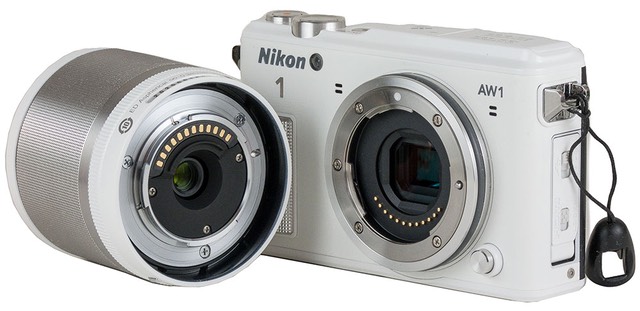
Note the lip over the rear of the lens and the gasket on the outside of the lens mount on the camera itself (dark ring). These two items are what form the seal between lens and camera.
I wish it were easy to change lenses anywhere, but that wasn’t exactly happening even when my camera was only kept in one environment. On my sample—but not on most of the others—my lens just likes to stay on the camera. I have to use a lot of force to twist the lens out of the sealed mount. This seems to be worse on my 11-27.5mm AW than my 10mm AW lens, so I suspect that my zoom just has slightly thicker, drier rubber gaskets. I’ve tried applying some old Nikonos grease to the rings, and that seemed to help a bit, but my camera/lens combo is still tighter than the others I tried, and tighter than I’d ever expect even a sealed lens mount to be.
I had thought that the rubber protective case Nikon sells would have given me better grip on the camera, but it wasn’t the best of material choices on the part of Nikon. While it’s better than the shiny plastic/metal case of the camera itself in terms of grip, it’s still a bit too slippery of a plastic for my taste. That’s especially true of the slight right grip, unfortunately. I choose to use a hand strap on my camera (with additional flotation) so that if I did lose grip in the water the camera didn’t float to the bottom of the ocean. Don’t laugh. We lost one of the Olympus Tough cameras on the trip when it slipped out of a pocket while on our Zodiac. Slippery near water doesn’t mix. Have a safety strap.
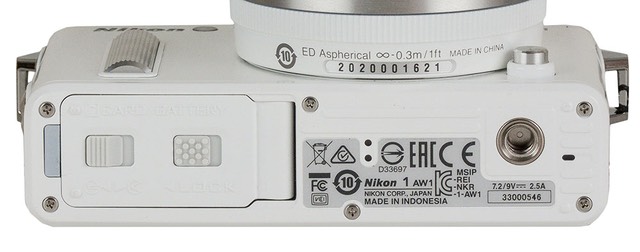
Note the double latch on the battery compartment door. You have to make sure both are in the proper position to ensure that the camera is protected from the elements. Ditto on the connections door on the side of the camera.
The door latch for the battery chamber is now squeaky on my sample after nearly a year’s use, though it seems to work just fine. The double latch system isn’t as robust a design as I’d have liked (the “lock” latch basically keeps the regular latch from moving to the open position). I’d have preferred two locks and a latch restrainer on the second one. But the system seems to work fine. The same system is used on the connector door, as well. I would have preferred that the connectors, battery, and card all be behind a single door. Having two doors to check increases the likelihood that you’ll someday forget a latch and trigger a camera flood.
In terms of shooting, the AW1 is pretty much just like the earlier J models (see my reviews for handling issues). It handles like a Nikon compact camera for the most part. One thing I don’t like is the addition of a menu of menus step. This means that changing settings via menu—which is your primary choice since the camera doesn’t really have configurable buttons and uses only the Direction pad to change anything during shooting—takes way too long and is a bit of a chore when in the water.
While the controls (buttons and Direction pad) are more robust and a little easier to find with the finger on the AW1 than the J3, they’re still small and difficult to use while swimming. Nikon also needs to drop the “glove-friendly” aspect of their marketing, too, as even my thinnest snorkeling/paddling gloves make getting the right button pressed difficult.
Thus, you really need to get everything set before you start snorkeling with the camera and then just pretty much stick with those settings, changing only the aperture (via the zoom buttons) and maybe exposure compensation (via the Direction pad) as you shoot. Anything else gets to be too much attention to the camera and not enough attention to your surroundings. This is a shame. Nikon had the chance to rethink the UI for real water use, but they basically didn’t. So much for solving user problems.
How’s it Perform?
Performance underwater while snorkeling was better than I thought it would be. As my teaching assistant Tony put it, you basically two-hand the camera in front and below you while you and try to swim to your subject (hope you have good fins). The LCD is good enough for basic composition, though you need to keep your mask from fogging if you want to see it clearly.
In the end you put a lot of trust in two things: the focus system and the Auto ISO system. Unfortunately the latter doesn’t have a minimum shutter speed setting, and for some strange reason, still doesn’t have an A1600 setting (you can choose ISO 800 or 3200 or 6400 as maximum ISO, but not 1600). Is Nikon really that dense that they can’t fix something that simple? Indeed, A1600 is exactly where I wanted to set my AW1 most of the time, but couldn’t. And a minimum shutter speed is also really necessary if you’re going to shoot fish underwater. They swim, you know. Usually faster than I do.
Focus: The good news is the focus system is very good even when snorkeling, especially since you’re likely to stay wide due to the compression effect of the water (the 10mm is what I’d tend to use snorkeling, and thus ignore zooming, as you’re too busy already with other controls and swimming). In fact, no one had any real issues with getting focus on subjects, even the faster moving ones (sea lions and penguins), unless they happened to get too close. As with the other Nikon 1 cameras, Nikon basically nailed the focus performance for a small camera.
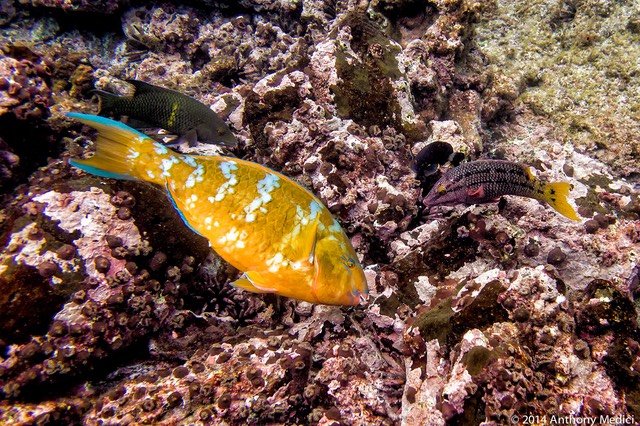
Interestingly, the AW1 was tending to ignore close backgrounds most of the time when focusing underwater, at least if you can keep the subject on or near the focus indicator you’re using. ISO 160, 10mm
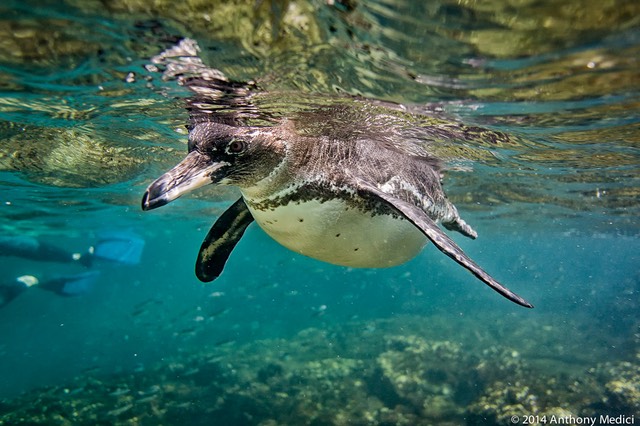
Even with raw processing done well, underwater is a bit of a nightmare for color. Note the slight green cast on the body in Tony’s fairly straight post processing above. I had to pull quite a bit of green and add blue and cyan to get most of that cast out, but now the blacks are going a bit magenta. This is one of the reasons why I think Nikon really needs to look at a new Picture Control for JPEG shooters: most underwater work needs a different hue base than above water work.

If you’re wondering which of these renderings is correct: neither. This is one of the big problems with snorkeling photography, actually. Tony’s rendering is correct for the part of the penguin being lit from above, my rendering is correct for underside that is getting reflections from the bottom. Still, there’s not enough red and too much green in both areas in Nikon JPEGs.
GPS/Depth: The two cameras I checked for location data both gave bogus readings for depth, and drained batteries quickly tracking GPS. My assistant’s AW1, even after the calibration procedure Nikon suggests, insisted that he was shooting at 1500 feet under water. That’s pretty good for a snorkeler ;~). I have this fear that this value is remembered by the camera, and that cameras going back to Nikon for repair will be checked to see if they exceeded Nikon’s suggested usage. Sorry, Nikon, if you don’t calibrate the camera right the data is wrong, yet when you do calibrate the camera it is often still wrong.
Image Quality: Whoever did the Auto WB and Underwater WB settings needs to have their eyes tested for color issues. Neither seemed to produce correct color in shots for anyone (generally too much green, not warm enough). Moreover, where’s a well-defined Underwater Picture Control, Nikon? (Higher contrast, different color balance so hue shifts work better). It seems to me like all of the effort went into building the sealed shell of the camera, and none into the rest. That’s lazy engineering, something I’m finding happening with more and more Nikon products these days.
Which is a shame, because the J3 is a decent compact-type camera and having an underwater version of it is something I found desirable, which is why I picked one up. My first impression is basically this: it’s sealed well enough for my needs, but that’s the only thing Nikon did for me (or you). I expect better. Frankly, if my engineering staff produced so little on such a product, they’d all be fired. The Nikonos engineers have all left the building, it seems.
That said, with post processing work (fortunately we were shooting in raw), I think everyone managed to get some unique shots in the Galapagos, and it would be far tougher to do that with a Tough (Olympus) or Coolpix (AW1##). So good on that. The Nikon 1’s survive because—despite all the drawbacks Nikon seems to encumber them with—they are better compacts than compact cameras, and they have great focusing ability. But for the prices Nikon wants, we deserve better. So fire the lazy engineers and find some that can solve real user problems. Please. Soon.
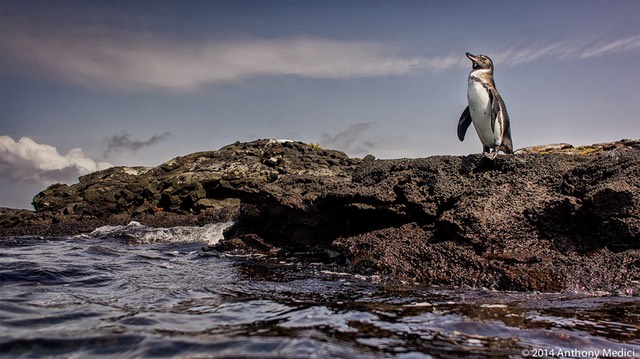
This is one of those images that would be difficult to get with any other camera. It was taken while swimming in the water. The perspective of that position is what gives the penguin a bit more nobility (king of the landscape). From a boat, even the small change upward in position tends to nullify the impact. The good news is that the AW1 is a perfectly competent above-water camera, too.
Final Words
If you need a camera that can endure virtually anything you can throw at it (cold, water, blowing sand, whatever), you basically have three choices these days:
- “Tough” compact: Fujifilm XP70, Nikon Coolpix AW110, Olympus Tough TG-3, etc.
- The Nikon AW1
- Any digital camera with an appropriate underwater housing
The first group, compact cameras, are highly limited by their small sensor sizes, and I don’t believe any of them shoot anything other than JPEG. Certainly for snorkeling or shallow diving, those limitations will come into play very quickly, as you’ll be bumping ISO fairly high and not a single camera I’ve tried gets underwater white balance close to correct, so you’ll be post processing 8-bit data to get correct color and can easily provoke posterization.
The last group, cameras in housings, gives you lots of flexibility (and the potential to use your existing camera), but adds lots of expense and bulk to the equation.
Which brings us to where Nikon has targeted the AW1: the Goldilocks solution, or “just right.”
To a fair degree, they hit that mark. The AW1 isn’t too bulky to handle while swimming, it’s sensor is large enough to give you reasonable results, at least while snorkeling in sunny conditions, and of course we get the Nikon 1’s fast focus abilities thrown into the mix, too. That said, the AW1 is a bit cumbersome to change settings while swimming, and you’re still going to be doing post processing to get color and contrast right.
On the flip side, the AW1 is the near perfect beach or skiing “compact” camera. Something small enough that you won’t mind carrying it, rugged enough to endure abuse, yet competent enough to give you raw files that can produce quite nice image quality under most conditions.
The operant question is this: is it worth it? US$750 (camera plus 11-27.5mm lens) is a lot to pay for what is basically a competent compact camera with a bit extra (raw support, larger sensor, faster focus). I can get a true underwater dive housing for my Sony RX100 for US$500-600, for instance, and a cheap one for US$130. Or I could take the “baggy” approach (e.g. Ewa-Marine) with virtually any small camera I’ve got in the gear closet for less money than the AW1 costs.
I’ll be headed to the Galapagos again later this year, and yes, my AW1 will be coming with me again. For some purposes, there really isn’t a better compromise choice than the AW1. As a general shooter, you’d be better off with a J4 if you like this style/size of camera. So the bottom line seems simple for me: if you need the waterproof and ruggedness, then the AW1 is pretty much the best choice of anything made directly for that. You have to sacrifice image quality (tough compacts) or convenience (underwater housings) otherwise. Thus, if you need it, buy it. If you don’t need it, you certainly wouldn’t buy it.
2018: this model is out of production and no longer available new. But used copies can easily be found.
Support this site by purchasing from this advertiser:
